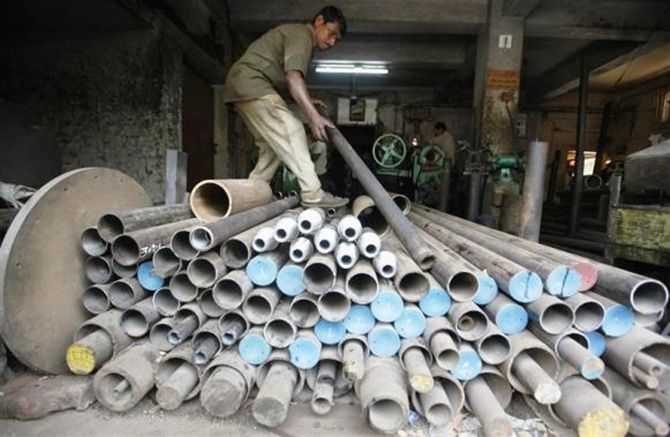 Success in manufacturing is not just about being cheap -- cheap labour, cheap land, cheap power and low or no taxes, says Ajit Balakrishnan.
Success in manufacturing is not just about being cheap -- cheap labour, cheap land, cheap power and low or no taxes, says Ajit Balakrishnan.
When the talk turns to finding jobs for India's young millions, "manufacturing" is invoked - if only India could manage to build a strong manufacturing sector just as our sibling rival China has done, all our job-creation worries would disappear.
But it is perhaps also true that the word "manufacturing" evokes a vision of mindless, repetitive work on an assembly line first caricatured in Charlie Chaplin's 1936 film Modern Times, with poor Charlie plodding away at a relentlessly moving assembly line watched over by a distrustful supervisor.
Thus, it is no wonder that solutions proposed for the "manufacturing problem" in India oversimplify the issue: change labour laws to make firing of workers easier than it is at present; make land available cheap (preferably free); declare tax holidays; and so on.
But there is some evidence from scholars who know a thing or two about manufacturing that most of this may be wishful thinking and the real solutions may lie elsewhere.
Success in manufacturing is not just about being cheap - cheap labour, cheap land, cheap power and low or no taxes.
Suzanne Berger of the Massachusetts Institute of Technology, who co-chaired the blue-ribbon Production in the Innovation Economy Commission set up to study this problem for the American economy (yes, they, too, yearn for more manufacturing jobs), points out that German manufacturing workers are paid wages 66 per cent higher than American workers, but Germany has a $20-billion-a-month trade surplus in manufacturing, whereas the United States, for the same month under study, October 2012, had a $14-billion trade deficit.
So even in America, low wages are not the key to manufacturing success.
She casts a similarly sceptical eye on the popular explanations for China's rise in manufacturing, most famously symbolised by Foxconn, whose factory in Shenzen, China, makes all the iPhones, iPads and the other state-of-the-art Apple products that we all love.
Analyses of Chinese growth, she says, emphasise low-wage labour; foreign direct investors bringing capital and manufacturing export experience from Taiwan, Hong Kong and the West; cheap land and cheap loans; and a protected and undervalued currency.
But, she says, the key to the success of Chinese manufacturers is that they excel at all forms of innovation that incorporate, enable and rapidly deliver products and solutions at the technological frontier even though they do not themselves initiate these technological innovations.
An Apple manager, quoted in the New York Times explaining why they make iPhones, iPads and iPods in China, says, "You need a thousand rubber gaskets? That's the factory next door. You need a million screws? That factory is a block away. You need that screw made a little different? It will take three hours."
It is, she says, the ecosystem that provides the competitive advantage to Chinese manufacturers.
In reality, all "manufacturing" and all manufacturers are not the same. One dimension to see the difference is by the degree of research and developed intensity, as a recent study in the European Union did.
At the lowest technological edge are units that make furniture, clothing and tobacco products.
At the next higher level are units that produce basic metals, rubber and fabricated metal products.
Above them are the car makers and the makers of medical equipment. At the highest technological level are those who make pharmaceutical, computer and optical products.
What is needed to nurture and grow each of these types of manufacturing is different.
Unknown to many in India, a Japanese academic, Shoji Shiba, has been working for the past decade to transform Indian manufacturing.
He has been trying to sensitise Indian managers and policymakers to the idea that success in manufacturing depends on mastering how to reduce the time to market from the moment you conceive of a new product, or a new feature in an old product; how to reduce frequent interruptions in production; and so on.
Thinking back over his work, he says the key to solving the Indian manufacturing puzzle is to change the widely held Indian understanding of manufacturing in the limited sense of "production".
This he calls the "small m" mindset. Manufacturing success depends on mastering several related aspects: design, research and development, sales, and supply chain.
Truly great manufacturing managers also need to understand issues like environmental change, societal change, as well as technological change. His clarion call is to change the "small m" mindset among Indian managers and policymakers to a "BIG M".
Encouraged by people like Sarita Nagpal of the Confederation of Indian Industry, and industrialists like Surinder Kapur and Jamshyd Godrej and V Krishnamurthy, Professor Shiba has been driving a management education programme called the Visionary Leaders for Manufacturing in line with its goal of training a new generation of visionary leaders in Indian manufacturing.
Students who join this programme spend their first three terms at the Indian Institute of Management (IIM)-Calcutta, the next two terms at the Indian Institute of Technology (IIT)-Kanpur and the IIT-Madras respectively, and return to the IIM-Calcutta for the final term.
It was William Blake who in his 1804 poem used the term "satanic mills" to describe the factories of the first Industrial Revolution that were springing up around him and, thus, encouraged many to view factories and factory work as grim and uncreative. May be it is time we left that antiquated notion about manufacturing behind us.
Ajit Balakrishnan, the founder and CEO of Rediff.com, is the author of The Wave Rider, A Chronicle of the Information Age. On Twitter: @ajitb












 © 2025
© 2025